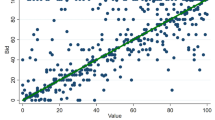Abstract
We construct a variant of the Vickrey auction of a single object where the surplus is split in exogenously fixed shares between the seller and the buyers, up to a margin of error vanishingly exponentially as the number of buyers grows. When the object is the common property of the participants, we can similarly construct VCG mechanisms with a vanishingly small cash transfer to the residual claimant. For any integer q, 3 ≤ q ≤ n, we find the mechanism guaranteeing to each participant a fair share of the qth highest valuation, while minimizing the worst possible ratio of the cash transfer to the efficient surplus. We perform a parallel analysis when the object is undesirable. We compare the cash lost to the largest spread between individual valuations, and obtain the same trade-offs between fairness and the relative loss of surplus.
Similar content being viewed by others
References
Alkan A, Demange G, Gale D (1991) Fair allocation of indivisible goods and criteria of justice. Econometrica 59: 1023–1039
Ando K, Kato M, Ohseto S (2008) Strategy-proof and symmetric allocation of an indivisible good. Math Soc Sci 55(1): 14–23
Aragones E (1995) A derivation of the money Rawlsian solution. Soc Choice Welf 12: 267–276
Atlamaz M, Yengin D (2006) Fair Groves mechanisms. Rochester University, Mimeo
Bailey MJ (1997) The demand revealing process: to distribute the surplus. Public Choice 91: 107–126
Cavallo R (2006) Optimal decision-making with minimal waste: strategyproof redistribution of VCG payments. International Conference on Autonomous Agents and Multi-agents Systems (AAMAS), Hakodate, Japan
Cramton P, Gibbons R, Klemperer P (1987) Dissolving a partnership efficiently. Econometrica 55(3): 615–632
Guo M, Conitzer V (2007) Worst case optimal redistribution of VCG payments. Conference on Electronic Commerce (EC), San Diego, June 2007
Green J, Laffont JJ (1979) Incentives in public decision making. North-Holland, Amsterdam
Holmstrom B (1979) Groves’ schemes on restricted domains. Econometrica 47: 1137–1144
Johari R, Tsitsiklis J (2004) Efficiency loss in a network resource allocation game. Math Oper Res 29(3): 407–435
Klijn F (2000) An algorithm for envy-free allocations in an economy with indivisibles objects and money. Soc Choice Welf 17: 201–215
Koutsoupias E, Papadimitriou C (1999) Worst case equilibria. In: Proceedings of the 16th Symposium on Theoretical Aspects of Computer Science, pp 404–413
Kunreuther H (1996) The role of compensation in siting hazardous facilities. J Policy Anal Manage 15(3): 601–622
Moulin H (1986) Characterizations of the pivotal mechanism. J Public Econ 31: 53–78
Moulin H (1992) An application of the shapley value to fair division with money. Econometrica 60(6): 1331–1349
Moulin H (2009) Efficient strategy-proof and almost budget-balanced assignment. J Econ Theory 144: 96–119
Moulin H (2008) The price of anarchy of serial, average and incremental cost sharing. Econ Theory 36: 379–405
Ohseto S (2006) Characterizations of strategy-proof and fair mechanisms for allocating indivisible goods. Econ Theory 29(1): 111–121
Papai S (2003) Groves sealed bid auctions of heterogenous objects with fair prices. Soc Choice Welf 20(3): 371–386
Porter R, Shoham Y, Tennenholtz M (2004) Fair imposition. J Econ Theory 118: 209–228
Roughgarden T, Tardos E (2002) Bad is selfish routing. J ACM 49(2): 236–259
Tennenholtz M (2001) Rational competitive analysis. In: Proceedings of IJCAI-01
Author information
Authors and Affiliations
Corresponding author
Additional information
This work was supported by the NSF under Grant SES-0414543. Several conversations with Geoffroy de Clippel are gratefully acknowledged.
Rights and permissions
About this article
Cite this article
Moulin, H. Auctioning or assigning an object: some remarkable VCG mechanisms. Soc Choice Welf 34, 193–216 (2010). https://doi.org/10.1007/s00355-009-0393-5
Received:
Accepted:
Published:
Issue Date:
DOI: https://doi.org/10.1007/s00355-009-0393-5




